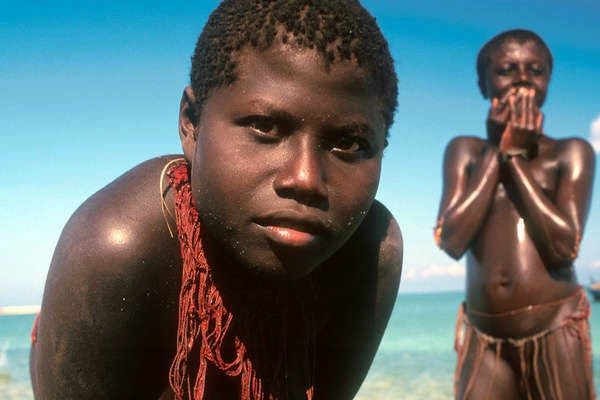Khoisan
An October 2012 genetic study published in Science Magazine found that the Khoisan in southern Africa are the oldest ethnic group of modern humans, with their ancestral line originating about 100,000 years ago. The Khoisan, formerly called by the derogatory term “Bushmen,” are genetically unique and no other currently known population had separated so early from our common modern human ancestor, according to the report.
The Khoisan live mainly in southern Africa, in territory spanning Botswana, Namibia, Angola, Zambia, Zimbabwe and South Africa. They are largely divided into two groups — hunters and gathers (Sans people) and keepers of livestock (Khoikhoi people). The Khoisan languages include the distinctive click sounds that aren’t found in the languages of their neighbors.
Australian Aborigines
Aboriginal Australians, also referred to as Aborigines, are the indigenous inhabitants of the Australian continent and the island of Tasmania. They are the descendants of the first people to leave Africa up to 75,000 years ago, according to a 2011 genetic study published in Science Magazine.
The study concluded the Aboriginal people are related much more closely to each other than to any people outside Australia, but scholars disagreed whether their closest kin outside Australia live in Asia or in Africa.
The researchers in the Science Magazine study found evidence, in DNA samples taken from strands of Aboriginal people’s hair, that the ancestors of their population split off from the ancestors of the European and Asian populations between 62,000 and 75,000 years ago—roughly 24,000 years before the European and Asian populations split off from each other.
These Aboriginal ancestors migrated into South Asia and then into Australia, where they remained. As a result, outside of Africa, the Aboriginal Australians have occupied the same territory continuously longer than any other human populations.
People of the Andaman Islands
The Andamanese are the various aboriginal inhabitants of the Andaman Islands, a territory of India located in the southeastern area of the Bay of Bengal. The population includes the Jarawa, Great Andamanese, Onge and Sentinelese ethnic groups, who are believed to have lived in their Indian Ocean home for up to 55,000 years.
Similar in appearance to the so-called “African Pygmies,” short, dark-skinned, with peppercorn hair and steatopygia (big buttocks), the Andamanese are direct descendants of the first modern humans to have inhabited Asia, according to a 2002 Stanford University study. They probably left northeast Africa by boat over 50,000 years ago and traveled along the coastlines of the Arabian Peninsula and India.
“They look like they belong in Africa, but here they are sitting in this island chain in the middle of the Indian Ocean,” said Dr. Peter Underhill, co-author of the Stanford study.
The islanders lack a distinctive genetic feature found among Australian aborigines, another early group to leave Africa, suggesting there were at least two separate emigrations of modern humans from Africa, Underhill said.
African ‘Pygmies’
The pejorative term “Pygmies” refers widely to a number of short-statured (men average less that 4’11” tall) African ethnic groups that live in a region that spans Rwanda, Burundi, Uganda, the Democratic Republic of the Congo, the Republic of Congo, the Central African Republic, Cameroon, the Equatorial Guinea, Gabon, Angola, Botswana, Namibia, Madagascar, and Zambia.
In the 1992 book, Conservation de la Forêt Dense en Afrique Centrale Et de L’Ouest, the authors assert that although “Pygmie” is often seen as derogatory, there is no single term to replace it. It’s safest to refer to these people by their specific ethnic groups such as the Mbenga (Aka and Baka) of the western Congo basin; the Mbuti (Efe, etc.) of the Ituri Rainforest, or the the Twa of the African Great Lakes.
This African population is extremely genetically diverse and the diminutive people are divergent from all other human populations, suggesting they have an ancient indigenous lineage, according to a July 2011 paper in the American Journal of Physical Anthropology. Their uniparental genetic markers represent the second most ancient gene pool, after those typically found in Khoisan people.
Researchers found these hunter–gatherers and farming populations diverged from a common ancestor 60,000 years ago, followed by a split of their ancestors into the Western and Eastern groups 20,000 years ago.
The Negritos
The word “Negrito,” literally meaning “little Black person,” is a term used by Spanish Europeans in reference to short Black people, specifically the indigenous people who populated Southeast Asia from the Andaman Islands near India to the Philippines. Taiwan and southern China are also included in this distribution, according to a 2004 Taipeitimes.com article.
Some of the Negrito ethnic groups are the Aeta, Batak, and Mamanwa of the Philippines; Semang and Orang Asli of Malaysia, Andamanese Islanders of the coast of India; and the Kunlun Nu of southern China.
Genetic testing suggests that the Negritos are at least partly descended from a group who migrated from eastern Africa more than 50,000 years ago, according to a 2006 Molecular Biology and Evolution article.
They are often grouped together with the so-called “African Pygmies” because their physical characteristics — which include short stature, very dark skin, woolly hair, scant body hair and steatopygia — suggesting a common origin.
However, the study concluded that the Negritos of Andaman Island, Malaysia, and the Philippines are, on the genetic level, are very distinct populations from each other, and among the most distant genetically from continental Africans of all humans on earth.
http://atlantablackstar.com/2014/07/13/5-ethnic-groups-that-prove-the-first-humans-were-black/5/




